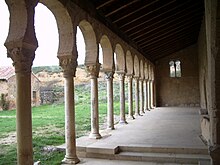Mozarab
Mozarab is a name for Christians who lived under Muslim rule in what is now Portugal and Spain ( Al-Andalus ) in the Middle Ages and who adapted their external way of life to the structures of Arab society.
etymology
The origin of the name Mozarabes ( Spanish Mozárabes , in older spellings also Mazárabes , Muzárabes , Mostárabes , Portuguese moçárabes) has not been finally clarified, but it is generally assumed that it comes from the Arabic termمستعرب / mustaʿrib is derived, which means something like "arabized".
history
The remaining Christian inhabitants of the Muslim-occupied territories on the Iberian Peninsula , who came under Moorish rule after the collapse of the Visigoth Empire (from 711) and adapted to the new lords in their outward way of life, are called Mozarabs. They had to pay jizya ( poll tax ), but lived in their own residential areas with their own jurisdiction and administration. The Arabization of Christians took place mainly in the cities, where many Christians were also active in the administration and the financial authorities of the Umayyads .
For the longest time, the Moorish rulers were quite tolerant of the Christian population (which was initially in the majority) and granted the religious freedoms possible under the Islamic legal system. Tensions only arose temporarily, for example in the 9th century when, under Muhammad I, at the instigation of the ascetics Perfectus , Eulogius and Isaak, religious excesses broke out in Cordoba . Between 851 and 859, Christians vilified and insulted Islam and its prophet Muhammad several times in order to endure martyrdom with the expected death sentence . It was only after a synod condemned wanton martyrdom that tensions subsided.
However, as a result of conversions to Islam, the number of Mozarabs in Islamic-ruled Andalusia steadily decreased over the centuries. With the progress of the Reconquista and the increasing orientalization of Andalusia, the migration of the Mozarabs to the Christian empires of the north also increased from the 10th century. This tendency intensified again when the Berber Almoravids and Almohads took over rule in Andalusia in the 12th century.They represented much more radical religious ideas than the previous rulers and increasingly exerted pressure and reprisals to get the Mozarabs to convert to Islam . Parts of the Mozarabs were also resettled to Morocco in order to withdraw people groups that were close to them from the Christian conquerors.
The immigrant Mozarabs established a connection between Latin-Christian and Muslim-Arabic culture in the northern Spanish kingdoms. They exerted considerable influence on folk poetry in northern Spain and southern France.
Mozarabic architectural style

With mozarabisch refers to interspersed with Islamic elements style Iberian artists, as found particularly in Spain. In the south, activities under the Moorish rule were limited to the decoration or the renovation and use of Visigothic churches.
There were numerous new buildings in the north. All over the country, the Mozarabs introduced new techniques to architecture , such as vaults and arches. However, the horseshoe arch attributed to the Moors already appears in Visigoth architecture . It was taken up by the Moors and with the Mozarabs came to the north in an orientalized form, while the architecture of Asturias Visigothic forms of the horseshoe arch survive in the pre-Romanesque period. In addition to the horseshoe arch, the Mozarabic architectural style is also characterized by the multi-pass arch and typical decorative forms such as plant ornaments made of stucco. Since the representation of people is forbidden in Islamic architecture, the Arab artists had perfected the skill of ornamental decoration. The Mozarab stonemasons took up these suggestions.
Mozarabic language
The dialects of Vulgar Latin spoken by the Mozarabs are known as the Mozarabic language .
Mozarabic rite
The liturgical rite of its own, which has survived to a small extent to this day and originated from the Visigoth tradition and was practiced by the Christians on the Iberian Peninsula (not only the Mozarabs) before the introduction of the Roman rite as part of the church reforms of the 11th century , is called Mozarabic Rite .
literature
- Stephan Ronart, Nandy Ronart: Lexicon of the Arab World. A historical-political reference work. Artemis Verlag, Zurich et al. 1972, ISBN 3-7608-0138-2 .

